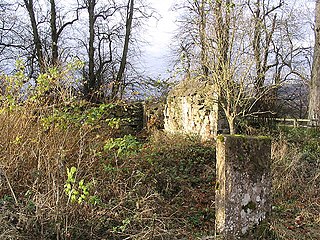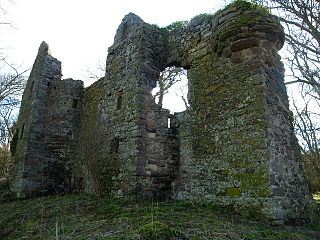Related Research Articles

John Welsh was a Scottish Presbyterian leader. He was born in Dumfriesshire and attended the University of Edinburgh to obtain his MA in 1588. He became a minister in Selkirk and married Elizabeth Knox, a daughter of John and Margaret Knox, before leaving Selkirk. Welsh later ministered at Kirkcudbright and Ayr, the latter of which was where he spent five years. His preaching resulted in his imprisonment by the order of King James VI of Scotland. The lawyer Thomas Hamilton wrote to James VI about Welsh, John Forbes, and others; the case was important because many Scottish subjects of James were devoted to the ministers. In 1606 Welsh was exiled to France, where he continued to preach. John Welsh of Ayr was the father of Josias Welsh and the grandfather of John Welsh of Irongray.

David Calderwood was a Church of Scotland minister and historian. Calderwood was banished for his nonconformity. He found a home in the Low Countries, where he wrote his great work, the Altare Damascenum. It was a serious attack on Anglican Episcopacy. Patiently and perseveringly Calderwood goes over the whole system, referencing the Bible, the Fathers, and the Canonists. Calderwood lived to see the principles for which he had suffered, and which he had defended, in complete ascendency. He was present at the Glasgow Assembly in 1638, and saw episcopacy and the high church liturgy swept away. He breathed his last at Jedburgh, a fugitive from his parish of Pencaitland; and they laid him in the churchyard of Crailing, where the first years of his ministry were spent.

Ludovic Stewart, 2nd Duke of Lennox and 1st Duke of Richmond, lord of the Manor of Cobham, Kent, was a Scottish nobleman who through their paternal lines was a second cousin of King James VI of Scotland and I of England. He was involved in the Plantation of Ulster in Ireland and the colonization of Maine in New England. Richmond's Island and Cape Richmond as well as Richmond, Maine, are named after him. His magnificent monument with effigies survives in Westminster Abbey.

Robert Pont (1529–1606) was a Church of Scotland minister, judge and reformer. He was a church minister and commissioner and a Senator of the College of Justice.
John Douglas was Protestant Archbishop of St. Andrews from 1571 to 1574. As was tradition from the fifteenth to the seventeenth centuries, the Archbishop also took on the role of Chancellor of the University of St Andrews, as the University had strong links with the Pre-Reformation church.

Sir Adam Otterburn of Auldhame and Redhall was a Scottish lawyer and diplomat. He was king's advocate to James V of Scotland and secretary to Mary of Guise and Regent Arran.
Walter Balcanquhall (1548–1617), was one of the first Presbyterian ministers in Edinburgh after the Reformation in Scotland.

David Fergusson or Ferguson was a Scottish reformer and minister of the Church of Scotland. He twice served as Moderator of the General Assembly of the Church of Scotland: 1573 and 1578.

The Jacobean debate on the Union took place in the early years of the reign of James I of England, who came to the English throne in 1603 as James VI of Scotland, and was interested in uniting his Kingdoms of England and Scotland. With one monarch on the two thrones there was de facto a "regnal union", but since James was very widely accepted in England, the debate was not on that plane. A political union was more controversial and is often referred to as a "statutory union", underlining the fact that the legal systems and institutions involved were different, and had had distinct historical paths. That wider union did not in fact come about in the 17th century, but at the time of the Union of England and Scotland in 1707, arguments from the earlier period were again put into circulation.
Andrew Simson (c.1526–c.1591) was a Scottish minister and schoolmaster.
Brian Paul Levack is an American historian of early modern Britain and Europe.
Barbara Napier or Naper was a Scottish woman involved in the 1591 North Berwick witch trials. Details of charges against her survive, and she was found guilty of consulting with witches, but it is unclear if, like the other accused people, she was executed.

John Wemyss younger of Logie, (1569-1596), was a Scottish courtier, spy, and subject of the ballad "The Laird o Logie", beheaded for plotting to blow up a fortification at Veere in the Netherlands
Sir James Sandilands was a courtier to King James VI and I and captain of Blackness Castle
John Spottiswood (1510–1585) was a religious reformer in 16th century Scotland.

John Davidson (c.1549–1603) was born in Dunfermline, where his parents owned property in houses and lands. He entered St Leonard's College, St Andrews, in 1567, and after graduating, became a regent of the college, pursuing the study of theology. Being introduced to John Knox, he set himself to advance the cause of the Reformation, and one of his earliest services was the production of a play intended to expose the errors of Romanism, which was acted in Knox's presence. In 1573 there appeared from his pen Ane Breif Commendation of Uprightness, a poem in praise of Knox, with accompanying verses on the Reformer's death. Soon after, another poetical tract was issued anonymously, under the title of Ane Dialog, or Mutitait Talking betwixt a Clerk and ane Courteour, concerning foure Parische Kirks till ane Minister. This was a reflection on the Regent Morton, who had been uniting parishes under one minister to secure part of the benefices for himself. The Regent was deeply offended. Printer and poet were put in prison. On his liberation, he lay hid for a time at Kinzeaneleugh, Ayrshire, the residence of his friend Robert Campbell. He then retired to the Continent, where he remained for about three years. In 1577, at the urgent solicitation of the General Assembly, Morton permitted his return, and in 1579 he became minister of Liberton. In June 1581, Morton being under sentence of death was visited by Davidson. Going for a time to London, he became known at the English Court, and from the earnest style of his preaching was called the thunderer. Returning, he did not resume his charge at Liberton, but officiated in various places. and acted as minister of the Second Charge of Holyrood. In 1595 he became minister Prestonpans, and built a church and manse at his own expense. He vigorously resented the proposal that certain of the clergy should sit and vote in Parliament, and words that he then uttered were often repeated : "Busk him, busk him as bonnily as ye can, and bring him in as fairly as ye will, we see him well eneuch, we see the horns of his mitre." He was summoned before King James at Holyrood, and committed to Edinburgh Castle, but released, and allowed to return home, though interdicted from going beyond the bounds of his parish. He died in September 1604.
Patrick Simson (1566-1618) was a presbyterian minster who served in Stirling during the reign of James VI of Scotland. Despite his opposition to Episcopalianism, he had the respect of king James and several of his court. He was born in Perth in 1556. He was from a prominent church family and was the son of Andrew Simson, minister of Dunbar. He was educated at St. Mary's College, St Andrews, graduating with an M.A. in 1574. He became a reader at Borthwick and completed his education at Bridgestock in England stopping there while intended for Cambridge as he met a gentleman who allowed him use of his library. He was admitted to Spott in 1577 and translated to Cramond in 1582. He was admitted to the vicarage there on 30 August 1586. He was translated and admitted to Stirling on 7 August 1590. He was presented by James VI on May 1591. When preaching before the King in 1598 he exhorted him to beware "lest he drew on himself secret wrath by setting up manifest idolatry." Immediately after the sermon his Majesty arose and "forbade him to meddle in these matters." He was a member of twelve out of fifteen Assemblies held prior to 1610. Simson was proposed by Assembly of 1606 "Constant Moderator" of Presbytery, but he lost to James Nicolson. He drew up a Protest to Parliament against the introduction of Episcopacy on 1 July 1606. He was chosen as Moderator of Conference at Falkland on 15 June 1608. Simson was offered a bishopric and pension by the King, but frequent attacks of disease broke down his constitution, and he died on 31 March 1618.
Archibald Simson, born in 1564, was the son of Andrew Simson. He was educated at University of St Andrews, graduating with an MA in 1585. He became assistant minister to his father at Dalkeith in 1586. Archibald was made clerk to the Presbytery on 10 October 1588. He was ordained on 3 June 1591.
John Graham, Lord Hallyards (c.1530–1593) was a Scottish lawyer and Senator of the College of Justice who sat in judgement in two famous trials in Scottish history. He was murdered in a feud.
References
- ↑ Mungo Russell sold cloth to Mary, Queen of Scots, Accounts of Treasurer, vol. 11 (Edinburgh, 1916), p. 511.
- ↑ John Row, The History of the Kirk of Scotland, from the Year 1558 to August 1637 (Edinburgh, 1842), p. 468.
- ↑ STC (2nd ed.) 21459: Reprinted in James Thomson Gibson-Craig, Marriage of King James the Sixth, Edinburgh, 1838
- ↑ Paulina Kewes & Andrew McRae, Stuart Succession Literature: Moments and Transformations (Oxford, 2019), p. 285.
- ↑ David Stevenson, Scotland's Last Royal Wedding (Edinburgh, 1997), p. 144: Thomas Thomson, History of the Kirk of Scotland, vol. 5 (Edinburgh, 1844), p. 97: James Thomson Gibson-Craig, Marriage of King James the Sixth (Edinburgh, 1838), pp. 39-40: 'The Joyfull Receiving', Edinburgh Magazine, vol. 12 (Edinburgh, 1799), p. 440: 'The Joyfull Receiving', Scots Magazine, vol. 61 (Edinburgh, July 1799), p. 344
- ↑ Lawrence Normand & Gareth Roberts, Witchcraft in Early Modern Scotland: James VI's Demonology and the North (Exeter, 2000), pp. 211, 248, 270: Calendar State Papers Scotland, vol. 10 (Edinburgh, 1936), p. 523 no. 572.
- ↑ Marguerite Wood, Extracts from the Burgh Records of Edinburgh, 1589-1603 (Edinburgh, 1927), pp. 205, 224-6.
- ↑ Bruce R. Galloway & Brian P. Levack, The Jacobean Union: Six Tracts of 1604 (Edinburgh: SHS, 1985), pp. liv-lxi, 75-141
- ↑ Bruce R. Galloway & Brian P. Levack, The Jacobean Union: Six Tracts of 1604 (Edinburgh: SHS, 1985), pp. 97-99.
- ↑ Charles Poyntz Stewart, Historic Memorials of the Stewarts of Forthergill, Perthshire (Edinburgh, 1879), pp. 118-9.
- ↑ James Paterson, Scottish Surnames: A Contribution to Genealogy (Edinburgh, 1866), p. 57.
- ↑ David Masson, Register of the Privy Council, 1599-1604, vol. 6 (Edinburgh, 1884), pp. 382, 388.
- ↑ Register of the Great Seal, 1593-1608 (Edinburgh, 1890), p. 539 no. 1476
- ↑ Charles McKean, Edinburgh: An Illustrated Architectural Guide (Edinburgh, 1982), p. 84.
- ↑ David Laing, Original Letters of John Colville (Edinburgh, 1858), pp. xiii, xxxviii-ix.